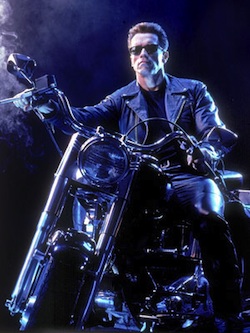July 3, 1991. The sequel to a successful science fiction/action movie is released. It is yet another movie from writer/director James Cameron, who has been enjoying his success from earlier movies such as Aliens, The Terminator, and The Abyss. As such, there is an amount of hype. People are excited, even me, and I was only eight years old. This movie is one of the great blockbusters of summer. It is slated over Independence Day week, releasing on a Monday of all things. It had an estimated $94,000,000 budget, large even in today’s money, and far more when you look at relative worth, which in comparison would be between $150-$230 million in 2010 dollars. It is a gamble, and it not only paid off, but changed the game for science fiction movies, in some ways wonderfully, but in some ways horribly.
Prior to Terminator 2, CGI and special effects in science fiction movies were occasional little flares, a blow-you-away scene and “big reveal,” such as the living water in The Abyss or the robo-skeleton at the end of The Terminator. Terminator 2 changed that. We have giant feats of CGI in every other scene. Liquid metal turning into all sorts of things, from other people to the floor under your feet. And the biggest thing, the one shocker that still surprises me, is that it looked amazing. It didn’t break my mental frame. It wasn’t an artifact thrown in that distracted from the story. It was just there, a fact of life, and we went on with the show.
This is extremely important, because had Terminator 2 failed to integrate the effects with the story, I have a feeling it would have bombed and pushed back further development in CGI, developments that gave us movies like Lord of the Rings and TV shows like Firefly. To give a comparison of what such a flop would have done, look what kind of delay on completely computer-animated movies happened after Final Fantasy: The Spirits Within bombed. Futher development with life-like computer animation was not really approached again until the Star Wars prequels, to a lesser extent, and Avatar (which I really don’t want to get into in this post) to a greater.
But, there is a dark side to what Terminator 2 did. As with any movie that succeeds, directors, writers, and producers will look at it and try to dissect what made it a blinding success. Once they think they have that answer, they will run with the idea and try to make as many other movies as they can that have that same nutshell answer.
In the case of Terminator 2, it seems like the answer many came away with was that a science fiction movie needs to have excessive computer graphics in as many frames as possible, and it needs to showcase them. This gave us movies like The Golden Compass, where a good story was completely jumbled up as screen time was wasted on the broad and expansive CGI-vista shots. This gave us every SyFy original ever made (okay, I might be exaggerating, there have been good SyFy shows) where the story and script are weak from the get go, so all the show has to rely on are what has now become the cheap patch of CGI.
Even Cameron himself has fallen prey to this glamour with (okay, I will get into it) Avatar. I will give that “Pocahontas and the Space Smurfs” was a beautiful movie to watch. I saw it in 3D, and yes, seeing Pandora like that was immersive. But so were the documentary films I saw at an Omnimax as a kid. A science fiction movie needs more than pretty special effects.
Which will bring me back to Terminator 2, which did have a compelling and well told story, characters you could sympathize with, “What if” questions that engaged the audience—such as could an artificial intelligence have feelings—and a strong and amazing (but not overpowering) garnish of special effects.
I think today’s science fiction movie makers need to realize that there is no “one thing” that makes a movie a success, and take a closer look at films like Terminator 2, and other successful successors to it, and realize that it doesn’t matter how many shape-shifting robots you have, if the story isn’t there, a bad movie isn’t going to shape-shift into a good one. A shame we can’t throw all of them into vats of molten steel, too.
So, this summer, if you haven’t watched Terminator 2 recently, or if you haven’t ever seen it, go and watch it. In fact, even if you have seen it recently, take a moment to appreciate it again. Appreciate the father of today’s computer graphics that still look better than half of its progeny, and enjoy a good story while you’re at it.
Richard Fife is a writer, blogger, and secret agent for the rise of Skynet. You can read his now complete serialized novel Revenent, the Tijervyn Chronicles Volume One, or if you think he is really awesome, you can always follow him on Twitter or Facebook.










